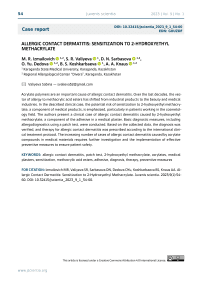Allergic contact dermatitis: sensitization to 2-hydroxyethyl methacrylate
Автор: Izmailovich M.R., Valiyeva S.R., Sarbasova D.N., Dedova O. Yu., Koshkarbaeva B.S., Knaus A.A.
Журнал: Juvenis scientia @jscientia
Рубрика: Клинические случаи
Статья в выпуске: 1 т.9, 2023 года.
Бесплатный доступ
Acrylate polymers are an important cause of allergic contact dermatitis. Over the last decades, the vector of allergy to methacrylic acid esters has shifted from industrial products to the beauty and medical industries. In the described clinical case, the potential risk of sensitization to 2-hydroxyethyl methacrylate, a component of medical products, is emphasized, particularly in patients working in the cosmetology field. The authors present a clinical case of allergic contact dermatitis caused by 2-hydroxyethyl methacrylate, a component of the adhesive in a medical plaster. Basic diagnostic measures, including allergodiagnostics using a patch test, were conducted. Based on the collected data, the diagnosis was verified, and therapy for allergic contact dermatitis was prescribed according to the international clinical treatment protocol. The increasing number of cases of allergic contact dermatitis caused by acrylate compounds in medical materials requires further investigation and the implementation of effective preventive measures to ensure patient safety.
Allergic contact dermatitis, patch test, 2-hydroxyethyl methacrylate, acrylates, medical plasters, sensitization, methacrylic acid esters, adhesive, diagnosis, therapy, preventive measures
Короткий адрес: https://sciup.org/14127230
IDR: 14127230 | DOI: 10.32415/jscientia_2023_9_1_54-60
Список литературы Allergic contact dermatitis: sensitization to 2-hydroxyethyl methacrylate
- Divkovic M, Pease CK, Gerberick GF, Basketter DA. Hapten-protein binding: from theory to practical application in the in vitro prediction of skin sensitization. Contact Dermatitis. 2005;53(4):189-200. DOI: 10.1111/j.0105-1873.2005.00683.x.
- Novak-Bilic G, Vucic M, Japundzic I, et al. Irritant and allergic contact dermatitis - skin lesion characteristics. Acta Clin Croat. 2018;57(4):713-720. DOI: 10.20471/acc.2018.57.04.13.
- Peiser M, Tralau T, Heidler J, et al. Allergic contact dermatitis: epidemiology, molecular mechanisms, in vitro methods and regulatory aspects. Current knowledge assembled at an international workshop at BfR, Germany. Cell Mol Life Sci. 2012;69(5):763-781. DOI: 10.1007/s00018-011-0846-8.
- Starokozhko LE, Gaidamaka II, Tishaeva AV. Otsenka effektivnosti pennogo intragastral'nogo kokteilya s azotom u bol'nykh atopicheskim dermatitom (Evaluation of the effectiveness of a foam intragastric cocktail with nitrogen in patients with atopic dermatitis). Medical News of North Caucasus. 2012;(2):69-71. (in Russ.). [Старокожко Л.Е., Гайдамака И.И., Тишаева А.В. Оценка эффективности пенного интра-гастрального коктейля с азотом у больных атопическим дерматитом // Медицинский вестник Северного Кавказа. 2012. № 2. С. 69-71]. EDN: PACPVL.
- Spencer A, Gazzani P, Thompson DA. Acrylate and methacrylate contact allergy and allergic contact disease: a 13-year review. Contact Dermatitis. 2016;75(3):157-164. DOI: 10.1111/cod.12647.
- van der Voort EA, van Neer FJ, Neumann HA. Acrylate-induced nail contact allergy. Int J Dermatol. 2014;53(9):e390-e392. DOI: 10.1111/ijd.12378.
- Piirila P, Kanerva L, Keskinen H, et al. Occupational respiratory hypersensitivity caused by preparations containing acrylates in dental personnel. Clin Exp Allergy. 1998;28(11):1404-1411. DOI: 10.1046/j.1365-2222.1998.00400.x.
- Raposo I, Lobo I, Amaro C, et al. Allergic contact dermatitis caused by (meth)acrylates in nail cosmetic products in users and nail technicians - a 5-year study. Contact Dermatitis. 2017;77(6):356-359. DOI: 10.1111/cod.12817.
- Symanzik C, Weinert P, Babic Z, et al. Allergic contact dermatitis caused by 2-hydroxyethyl methacrylate and ethyl cyanoacrylate contained in cosmetic glues among hairdressers and beauticians who perform nail treatments and eyelash extension as well as hair extension applications: A systematic review. Contact Dermatitis. 2022;86(6):480-492. DOI: 10.1111/cod.14056.
- Gonzalo M, Pinho A, Agner T, et al. Allergic contact dermatitis caused by nail acrylates in Europe. An EECDRG study. Contact Dermatitis. 2018;78(4):254-260. DOI: 10.1111/cod.12942.
- Gatica-Ortega ME, Pastor-Nieto MA, Silvestre-Salvador JF. Dermatitis alérgica de contacto por acrilatos en esmaltes permanentes (Allergic Contact Dermatitis Caused by Acrylates in Long-Lasting Nail Polish). Actas Dermosifiliogr (Engl Ed). 2018;109(6):508-514. DOI: 10.1016/j.ad.2017.08.010.
- Marrero-Alemán G, Sabater-Abad J, Miquel FJ, et al. Allergic contact dermatitis to (meth)acrylates involving nail technicians and users: Prognosis and differential diagnosis. Allergy. 2019;74(7):1386-1389. DOI: 10.1111/all.13736.
- Spencer A, Gazzani P, Thompson DA. Acrylate and methacrylate contact allergy and allergic contact disease: a 13-year review. Contact Dermatitis. 2016;75(3):157-164. DOI: 10.1111/cod.12647.
- Novitskii VV, Ryazantseva NV, Litvinova LS, et al. Mekhanizmy narusheniya kooperatsii eozinofilov i im-munotsitov pri formirovanii bol'shikh eozinofilii krovi (Mechanisms of impaired cooperation of eosinophils and immunocytes during the formation of large blood eosinophilia). Bulletin of Siberian Medicine. 2006;5(2):52-61. (in Russ.). [Новицкий В.В., Рязанцева Н.В., Литвинова Л.С., и др. Механизмы нарушения кооперации эозинофилов и иммуноцитов при формировании больших эозинофилий крови // Бюллетень сибирской медицины. 2006. Т. 5. № 2. С. 52-61]. EDN: HVEVPL.
- Long H, Zhang G, Wang L, Lu Q. Eosinophilic Skin Diseases: A Comprehensive Review. Clin Rev Allergy Immunol. 2016;50(2):189-213. DOI: 10.1007/s12016-015-8485-8.
- Herman A, Aerts O, Baeck M, et al. Allergic contact dermatitis caused by isobornyl acrylate in Freestyle® Libre, a newly introduced glucose sensor. Contact Dermatitis. 2017;77(6):367-373. DOI: 10.1111/ cod.12866.


